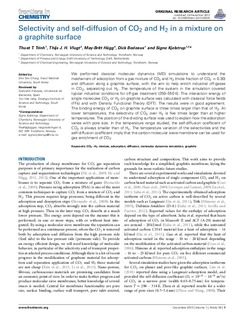| dc.contributor.author | Trinh, Thuat | |
| dc.contributor.author | Vlugt, Thijs J.H. | |
| dc.contributor.author | Hagg, May-Britt | |
| dc.contributor.author | Kjelstrup, Signe | |
| dc.contributor.author | Bedeaux, Dick | |
| dc.date.accessioned | 2017-10-26T07:56:42Z | |
| dc.date.available | 2017-10-26T07:56:42Z | |
| dc.date.created | 2013-12-13T16:57:18Z | |
| dc.date.issued | 2013 | |
| dc.identifier.citation | Frontiers in Chemistry. 2013, 1 (1), 38-?. | nb_NO |
| dc.identifier.issn | 2296-2646 | |
| dc.identifier.uri | http://hdl.handle.net/11250/2462263 | |
| dc.description.abstract | We performed classical molecular dynamics (MD) simulations to understand the mechanism of adsorption from a gas mixture of CO2 and H2 (mole fraction of CO2 = 0.30) and diffusion along a graphite surface, with the aim to help enrich industrial off-gases in CO2, separating out H2. The temperature of the system in the simulation covered typical industrial conditions for off-gas treatment (250–550 K). The interaction energy of single molecules CO2 or H2 on graphite surface was calculated with classical force fields (FFs) and with Density Functional Theory (DFT). The results were in good agreement. The binding energy of CO2 on graphite surface is three times larger than that of H2. At lower temperatures, the selectivity of CO2 over H2 is five times larger than at higher temperatures. The position of the dividing surface was used to explain how the adsorption varies with pore size. In the temperature range studied, the self-diffusion coefficient of CO2 is always smaller than of H2. The temperature variation of the selectivities and the self-diffusion coefficient imply that the carbon molecular sieve membrane can be used for gas enrichment of CO2. | nb_NO |
| dc.language.iso | eng | nb_NO |
| dc.publisher | Frontiers Media | nb_NO |
| dc.rights | Navngivelse 4.0 Internasjonal | * |
| dc.rights.uri | http://creativecommons.org/licenses/by/4.0/deed.no | * |
| dc.title | Selectivity and self-diffusion of CO2 and H2 in a mixture on a graphite surface | nb_NO |
| dc.type | Journal article | nb_NO |
| dc.type | Peer reviewed | nb_NO |
| dc.description.version | publishedVersion | nb_NO |
| dc.source.pagenumber | 38-? | nb_NO |
| dc.source.volume | 1 | nb_NO |
| dc.source.journal | Frontiers in Chemistry | nb_NO |
| dc.source.issue | 1 | nb_NO |
| dc.identifier.doi | 10.3389/fchem.2013.00038 | |
| dc.identifier.cristin | 1076715 | |
| dc.relation.project | Norges forskningsråd: 209337 | nb_NO |
| dc.relation.project | Notur/NorStore: nn9229k | nb_NO |
| dc.relation.project | Notur/NorStore: nn4504k | nb_NO |
| dc.description.localcode | © 2013 Trinh, Vlugt, Hägg, Bedeaux and Kjelstrup. This is an open-access article distributed under the terms of the Creative Commons Attribution License (CC BY). The use, distribution or reproduction in other forums is permitted, provided the original author(s) or licensor are credited and that the original publication in this journal is cited, in accordance with accepted academic practice. No use, distribution or reproduction is permitted which does not comply with these terms | nb_NO |
| cristin.unitcode | 194,66,25,0 | |
| cristin.unitcode | 194,66,30,0 | |
| cristin.unitname | Institutt for kjemi | |
| cristin.unitname | Institutt for kjemisk prosessteknologi | |
| cristin.ispublished | true | |
| cristin.fulltext | original | |
| cristin.qualitycode | 1 | |

